
A series of articles analyzing the Path in Eternity in light of an animated movie I created.

A series of articles analyzing the Path in Eternity in light of an animated movie I created.

I came to magick via an unsual path: through my interest in the German philosopher Georg Wilhelm Friedrich Hegel.
Hegel was not a magician. He was a late-18th/early-19th century philosopher in the idealist tradition (a branch of thought taking influence from Descartes, Berkeley, and Hume, but which is usually seen as having its origin with the Prussian philosopher Immanuel Kant).
But it was after I had been interested in Hegel for over a decade that I read Glenn Magee’s book, Hegel and the Hermetic Tradition. (You can read the introduction of the book here for free. It actually provides a pretty good orientation for how Hermetism differs from Gnostism and traditional Christianity.)
Magee persuaded me that Hegel’s philosophy of Absolute Idealism owed at least as much to Renaissance Hermetism (or Hermeticism as it’s sometimes called) as it did to rational thinkers such as Hume or Kant.
Magee understands Hermetism as a broad spiritual current which has a theological basis in the Corpus Hermeticum but which also includes currents such as Qabalah, alchemy, and magic.
Pretty much everything we consider to be the western magical tradition has its origins in Renaissance Hermetism, in particular the synthesis given to it by Cornelius Agrippa. (Really the only component missing from Agrippa’s synthesis is the tarot.)
For more on this I highly recommend Frances Yates’s Giordano Bruno and the Hermetic Tradition. Certain aspects of her work are considered controversial now. I recommend reading Copenhaver, Hanegraaff, and Kingsley alongside her.
One of the main impacts Magee’s book had on me when I read it is that—oddly enough—it legitimized occultism for me.
Hegel was a philosopher I had spent over a decade studying both in and outside of academia. I considered a lot of my philosophical intuitions to be “Hegelian”. The experience was a little bit like having lived in a house for several years and then one day discovering a secret sub-basement that wasn’t on any of the building plans.
I was becoming familiar with the Qabalah right around the time I read Magee’s book (largely due to the work of my friend Daniel Ingram who also legitimized magick for me), so I recognized the Tree of Life in its usual top-to-bottom arrangement. But I was surprised to find out that there had been alternative arrangements of the sephiroth over time, including one in which they were presented as concentric circles.
For instance, Johann Jakob Brucker gave them a circular arrangement in volume 2 of his influential Historia Critica Philosophiae (1742).
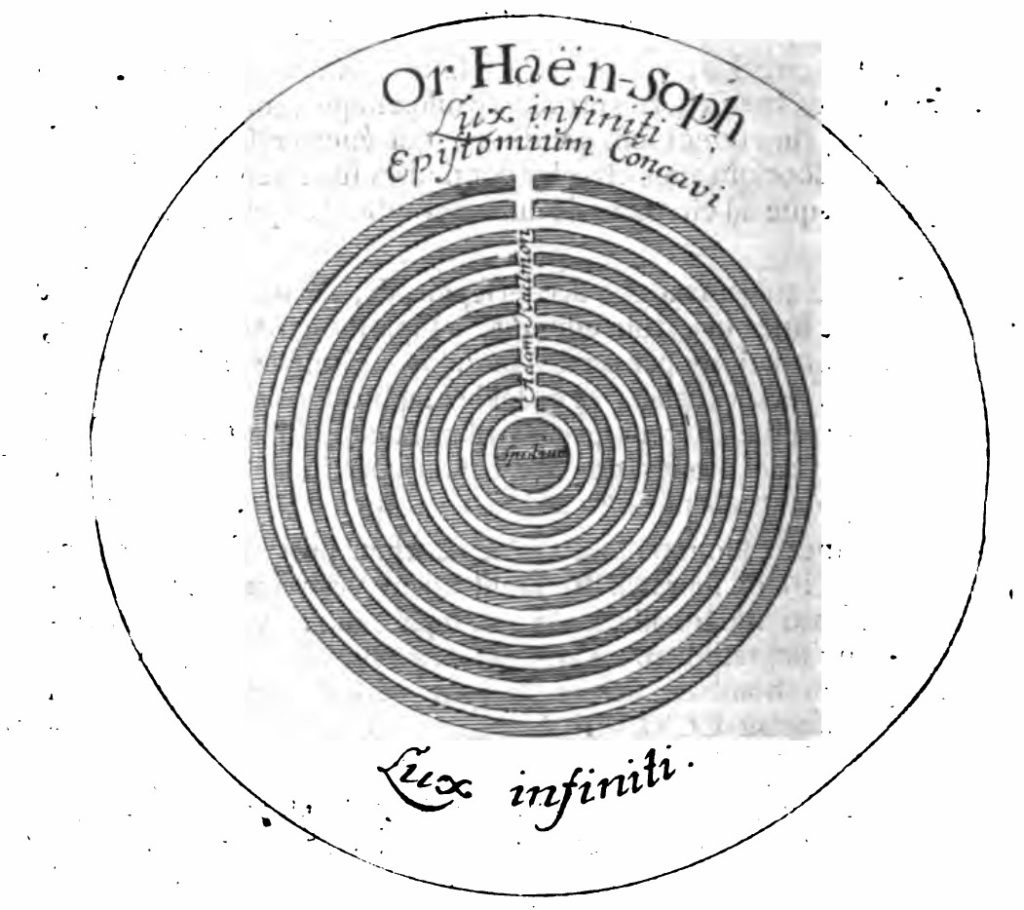
This diagram was Brucker’s attempt to illustrate a concept from the Lurianic tradition of Kabbalah, according to which each new act of creation or manifestation in the world is the result of a simultaneous contraction and expansion.
Isaac Luria and his followers envisioned the Ain Sof—the limitless infinity we previously identified with Nuit—as an infinite sphere in which a smaller sphere of empty space came into being through the tsimtsum, a primordial contraction or withdrawal of God.
It is into this empty space that God injects a ray of light which differentiates itself into the classical ten sephiroth. These were thought of as concentric circles of light filling the space within God created by the primordial contraction.
The first definite being that appears in the wake of the tsimtsum is Adam Kadmon (macroprosopus in the previous post). Adam Kadmon exists above the four worlds and mediates the light of Ain Sof into them.
Adam of the Bible—Adam Ha-Rishon—is an imperfect earthly embodiment of Adam Kadmon. While Adam Kadmon is spirit outside of space and time, Adam Ha-Rishon is spirit developing in nature, from the fall in the Garden of Eden and the loss of the immediate relationship to God, eventually to the recovery of that relationship in religion and mysticism (namely, Kabbalah).
(Ra-Hoor-Khuit is to Chaos as Adam Kadmon is to Adam Ha-Rishon.)
The implication of this concentric arrangement is that the material universe, individuals, and human history are not outside of the divine. Everything is in a certain sense “in” God. It’s just there in a corrupted or fallen state which has to be rectified over time.
This sense of us being in God, of directly participating in the divine all the time whether we know it or not, can be occulted by the traditional top-down arrangement of the sephiroth, where it looks as though Kether, Ain Sof, and Ain are somehow way above us mere earthlings.
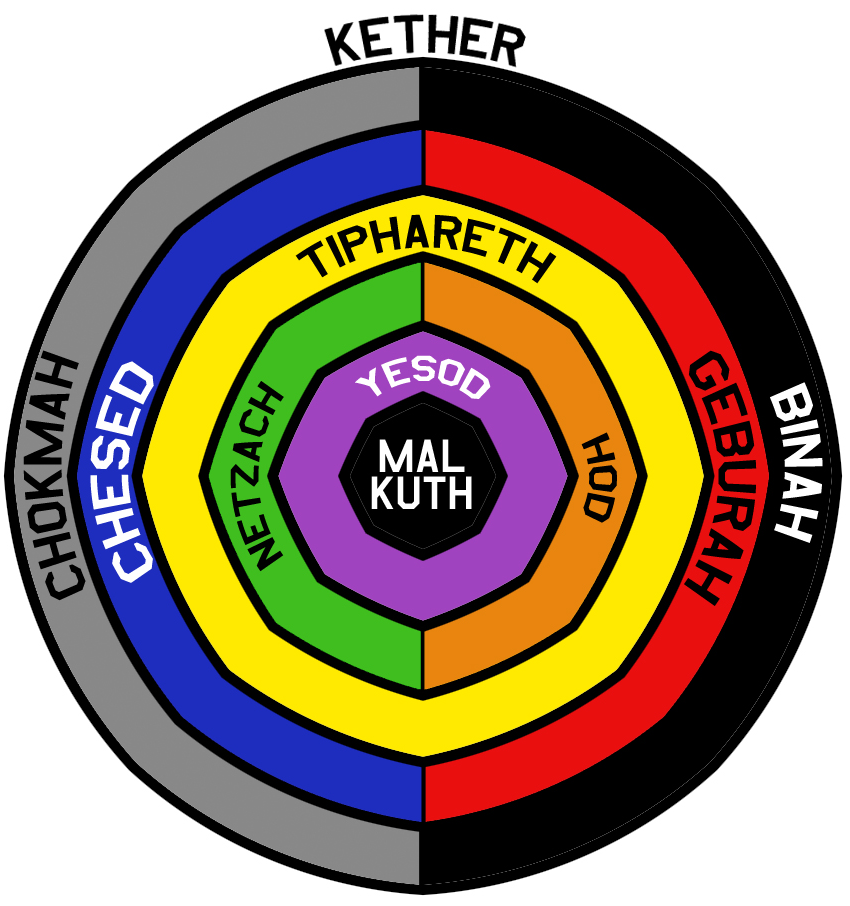
“A View from Kether” by IAO131
A few years later when I got into Thelema, I was pleased to see someone else had taken an interest in a similar arrangement. IAO131 created a diagram similar to Brucker’s in which Kether surrounds and contains the other sephiroth. My own version was inspired by his insofar as the sephiroth on the lateral pillars are depicted as semicircles rather than complete spheres.
What these concentric representations of the Tree of Life share in common is the implication that the reality we find ourselves in is one formed from an overarching, primordial, divine unity which divides itself.
There is some evidence in Crowley’s writings to support this view of our reality being the result of a self-division of God.
To know itself, each such Star, or Soul, must eat of the Fruit of the Tree of Knowledge of Good and Evil, by accepting labour and pain as its portion, and death as its doom. That is, it must reveal its nature to itself by formulating that nature as duality. It must express itself by a series of symbolic gestures ostensibly external to it, just as a painter reveals one facet of his Delight-Diamond by covering a canvas with colours in such a way that the picture seems at first sight to represent something outside himself. It must, in fact, repeat for itself the original Magick of Nuith and Hadith which created it.
New Comment on AL I.29 (emphasis mine)
AL I.29—of which this passage is a commentary—reads, “For I am divided for love’s sake, for the chance of union.”
We find in this passage echoes of the Lurianic idea of the fall as a temporary but necessary tragedy resulting from the diremption of an original, absolute whole (in this case the “Star, or Soul” of the individual).
The way to overcome this division is to repeat for ourselves the “original Magick of Nuith and Hadith” which created the star.
In this passage, Crowley presents the path toward liberation in artistic terms. The task is to see the world and the events in it, not as alien to our desires, but rather as vehicles for the manifestation of them. We are to view matter as (akin to) artistic medium.
The world loses its alien, painful character when it is understood and willed. When we can see the world as our own artistic creation, we have achieved liberation.
This is an interpretation of the Thelemic path of liberation I explored in my talk on the Magical Power of Art.
It was with something like this in mind that I formulated my own version of the concentric Tree of Life. However, unlike Brucker or IAO131, I reversed the order of the sephiroth. Rather than having Kether on the outside and Malkuth in the center, Malkuth is on the outside and Kether is in the center.
As it turns out, my reasons for doing this are numerous and complex. But before explaining any of them in detail, it’s worth mentioning that old adage that “the map is not the territory.”
I don’t believe sephiroth literally exist, let alone whether they are really, in any kind of metaphysical sense, related to one another externally or internally, or whether Malkuth can really be said to be at the center or not. That’s not really the point of a diagram.
In this context, the purpose of the diagram is to serve as a heuristic. It’s an attempt to convey some complex ideas in a simplified format that makes them easier to comprehend.
There could well be certain aspects of Thelema that are better captured by having Kether on the outside and Malkuth in the center, just as there are aspects that are better captured by the usual hierarchical (top-down) arrangement.
All of that being said, there are a lot of spiritual, metaphysical, theological, and soteriological assumptions packed into this simple decision to put Kether at the center and Malkuth on the outside.
Some of them require a lot of explanation and carry with them a lot of implications, so rather than go into any of them in depth right now, I’ll just list them succinctly.
I don’t know yet if I’m going to write posts about all of these. If there are particular ones you definitely want to hear about, though, let me know in a comment.
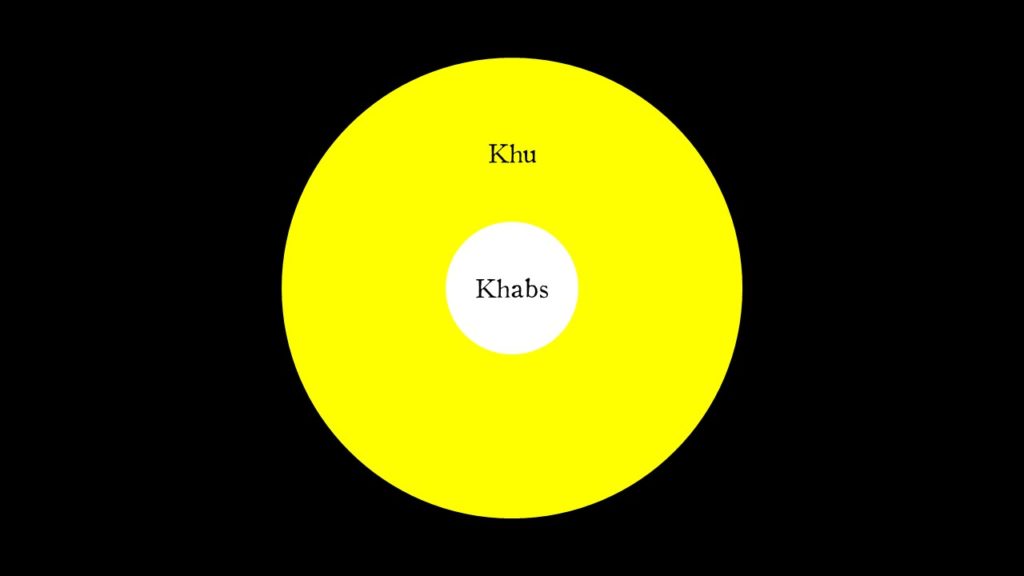
In the last post we saw that the star or soul of each individual is composed of two parts: the Khabs and the Khu. The Khabs is the manifestation of a distinct individual within the context of Nuit. The Khabs is the “house” of Hadit—your individual point of view—and as such it is the spiritual essence of who you are as an individual. We also saw that the Khabs is identical with the supernal triad on the Tree of Life, and as such it takes a triadic, reflective structure.
The Khu, on the other hand, is the “magical garment” of the star.
Khabs is the secret Light or L.V.X.; the Khu is the magical entity of a man […] This ‘star’ or ‘Inmost Light’ is the original, individual, eternal essence. The Khu is the magical garment which it weaves for itself, a ‘form’ for its Being Beyond Form, by use of which it can gain experience through self-consciousness
Old and New Comments on AL I.8
Each of us is Hadit, the core of our Khabs, our Star, one of the Company of Heaven; but this Khabs needs a Khu or Magical Image, in order to play its part in the Great Drama. This Khu, again, needs the proper costume, a suitable ‘body of flesh’, and this costume must be worthy of the Play.
New Comment on AL II.70
The Khabs represents the essence of who each of us is. It is possessed of the attributes of light, originality, individuality, and immortality. The Khu on the other hand is the mode by which the Khabs interacts with Nuit. If the Khabs is monistic (completely self-sufficient), the Khu is relational. It doesn’t exist without the interaction between the Khabs and Nuit.
And for that matter, the relationship between Khabs (or Hadit) and Nuit does not exist without the Khu. In other words, experience or embodiment of some kind is the necessary condition of the love “play” between Nuit and Hadit.
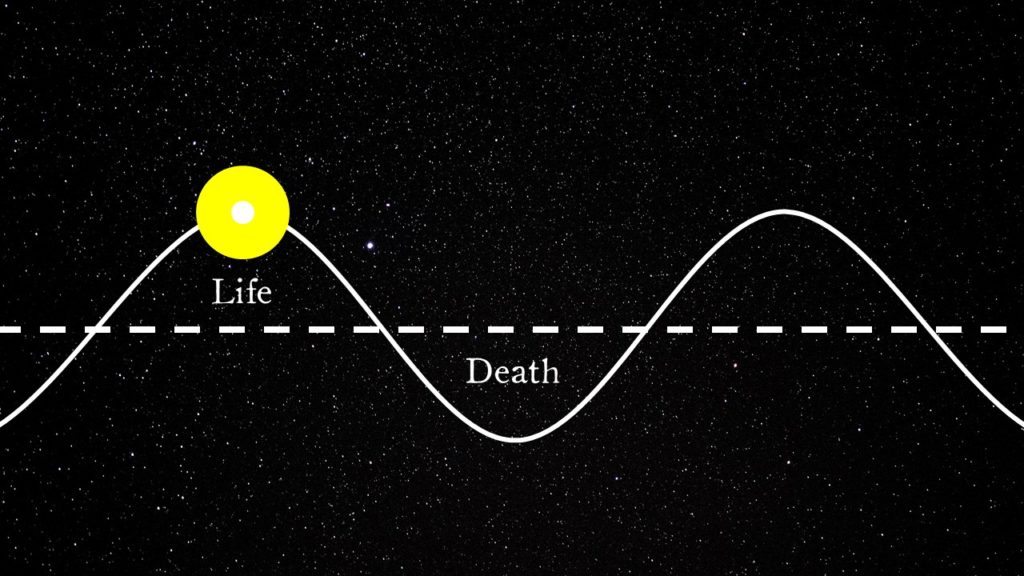
One answer to the question “Why do we incarnate?” is that incarnation (whether on this plane or some other) is a necessary precondition for Hadit’s going. In a subsequent post we can look at what some of the consequences of that are.
Unlike the Khabs of an individual which cannot be seen (arguably not even by the individual whose Khabs it is), since the Khu is relational, it is also manifest and can be seen either by the individual whose Khu it is or by others.
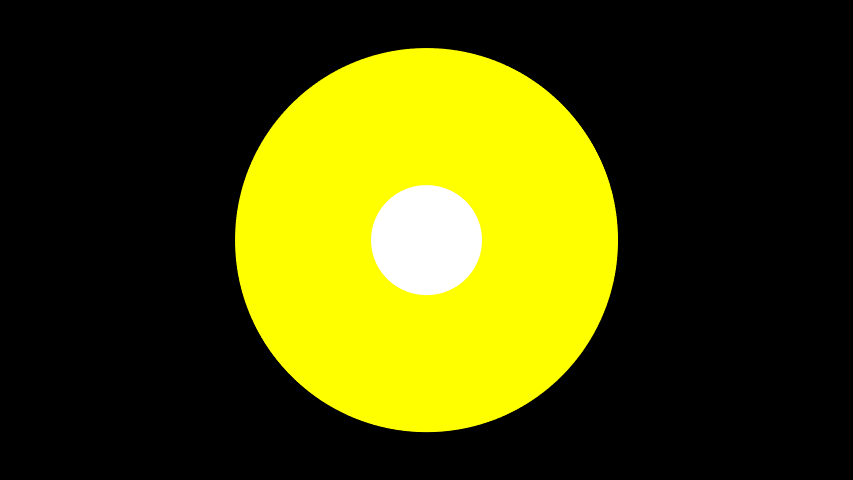
Also, since the Khu is a function of the interaction between the Khabs and Nuit, it is experiential and elastic. It grows and shrinks and changes in complexity in accordance with how much and what kind of experiences of Nuit one chooses to have.
“Every man and every woman is a star,” that is, an aggregate of such experiences, constantly changing with each fresh event, which affects him or her either consciously or subconsciously.
“Introduction” to the Book of the Law
the more complex the Khu of the Star, the greater the man, and the keener his sense of his need to achieve it.
New Comment on AL II.74
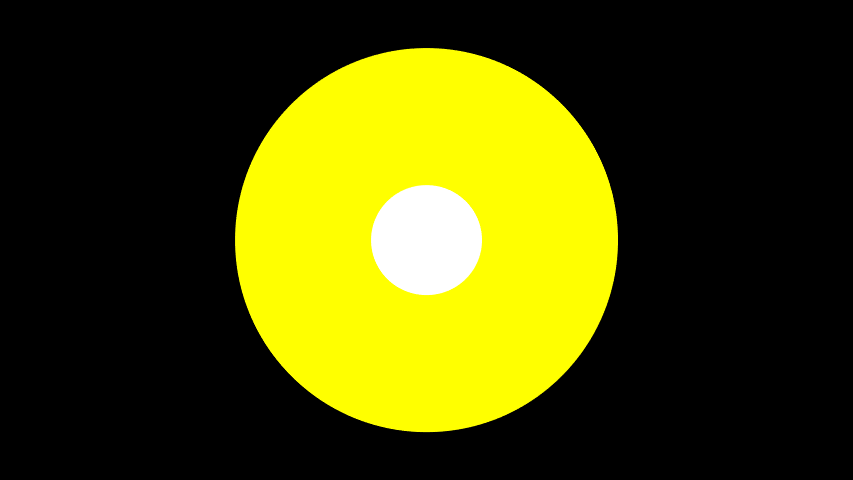
If the Khabs is the supernal triad on the Tree of Life, the Khu is composed of the subsequent seven sephiroth.
With each incarnation, the sephiroth below Binah are recreated anew, following the path of the Flaming Sword. At death, the lower sephiroth are jettisoned, and the essence of the Khabs is completely withdrawn back into the supernal triad.
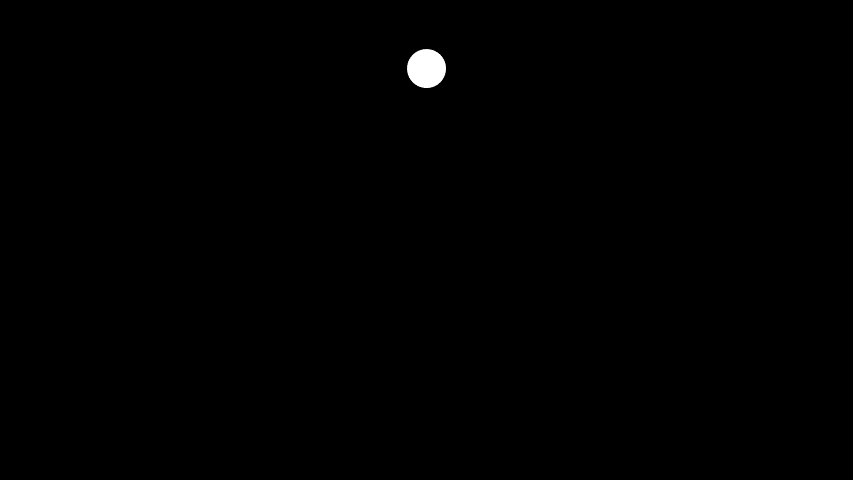
The exception to this is the individual who, through mystical and magical discipline, has opened and strengthened the pathways to their own Khabs.
[T]he Supernal Triad constitutes (or, rather, is an image of) the “eternal” Essence of a man [i.e., his Khabs]; that is, it is the positive expression of that ultimate “Point of View” which is and is not and neither is nor is not etc. Quite indestructible. Now when a man spends his life (a) building up and developing the six Sephiroth of the Ruach so that they cohere closely in proper balance and relation, (b) in forging, developing and maintaining a link of steel between this solid Ruach and that Triad, Death merely means the dropping off of the Nephesch (Malkuth) so that the man takes over his instrument of Mind (Ruach) with him to his next suitably chosen vehicle.Magick without Tears, chapter 38
Appear on the throne of Ra!
AL III.37
Open the ways of the Khu!
Lighten the ways of the Ka!

This is how the magical memory of a star can be built up over a series of incarnations.
This doctrine seems to imply that wisdom is not just passed down through the historical record but can also accumulate in certain stars on the Akashic plane.
Every star is already irreducibly individual and therefore unequal with any other star. But additionally it is also possible certain stars are “great beings” who, for reasons of having built up a magical memory over time, are possessed of extraordinary wisdom.
[C]ertain vast “stars” (or aggregates of experience) may be described as Gods. One of these is in charge of the destinies of this planet for periods of 2,000 years.“Introduction” to the Book of the Law
It’s possible Crowley understood this as the mechanism by which “Secret Chiefs” are created.
It would explain why he used names such as “Aiwass” and “V.V.V.V.V.” both as aspects of himself and as names of separate individuals. “Aleister Crowley” was merely the latest expression or mode (Khu) of an essence (Khabs) of which Aiwass and V.V.V.V.V. were others.
Crowley elaborates on metempsychosis in Liber Aleph, “De Adeptis R. C. Escatologia,” which should be studied closely by initiates of the III° of Mysteria Mystica Maxima.
But it is this continual extension and withdrawal of the Khu—and hence the relations of the Khabs with Nuit—which is visually depicted again and again in the movie.

Another relationship I establish at the beginning of the video is between the soul (which in Thelema is called the star) and the Tree of Life of Qabalah. (I use Kabbalah when talking about the Jewish mystical tradition itself and Qabalah when talking about the interpretation of it by the Golden Dawn and Crowley.)

That such a relationship exists shouldn’t be a surprise. The Tree of Life diagram is meant to show the relationship between the soul (the microcosm) and the four worlds (the macrocosm).
The bottom circle or sephira, Malkuth (“kingdom”), is Assiah (“the world of action”). It is often identified with the material world, although for reasons we’ll get into later, that is not necessarily the case in Thelema.
The microcosmic correlate of Malkuth/Assiah—the part of the soul that resides there—is the Nephesh. This is sometimes translated as “animal soul”. It is the part of the individual that is sentient, i.e., which experiences sensations and feelings.
Going upward from Malkuth, the next six sephiroth are Yesod (“foundation”), Hod (“splendor”), Netzach (“victory”), Tiphareth (“beauty”), Geburah (“severity”), and Chesed (“mercy”). Together they comprise the macrocosmic realm of Yetzirah (“the formed world”). Yetzirah is also known as Zeir Anpin or Microprosopus, the Lesser Countenance (in contrast with Arich Anpin/Macroprosopus).
The part of the soul that resides in Yetzirah is called the Ruach (“spirit”). It is typically identified with the moral soul or the discriminating capacity.
Above that we have Binah (“understanding”) and Chokmah (“wisdom”). Together they comprise Briah (“the world of creation”). This is analogous to the world soul of Neoplatonic philosophy.
The part of the soul that resides in Binah is called the Neschamah, the intelligence or divine intuition. The part of the soul that resides in Chokmah is the Chiah, which in Thelema it is identified with the creative will or impulse of Jechidah.
Jechidah is the “quintessential principle of the soul,” and it is identical with Kether, the uppermost sephira on the diagram, which is analogous to the One of Neoplatonic philosophy.
All three of the “supernal” sephiroth—Binah, Chokmah, and Kether—transcend time, but Kether also transcends being and non-being. It transcends opposition all-together.
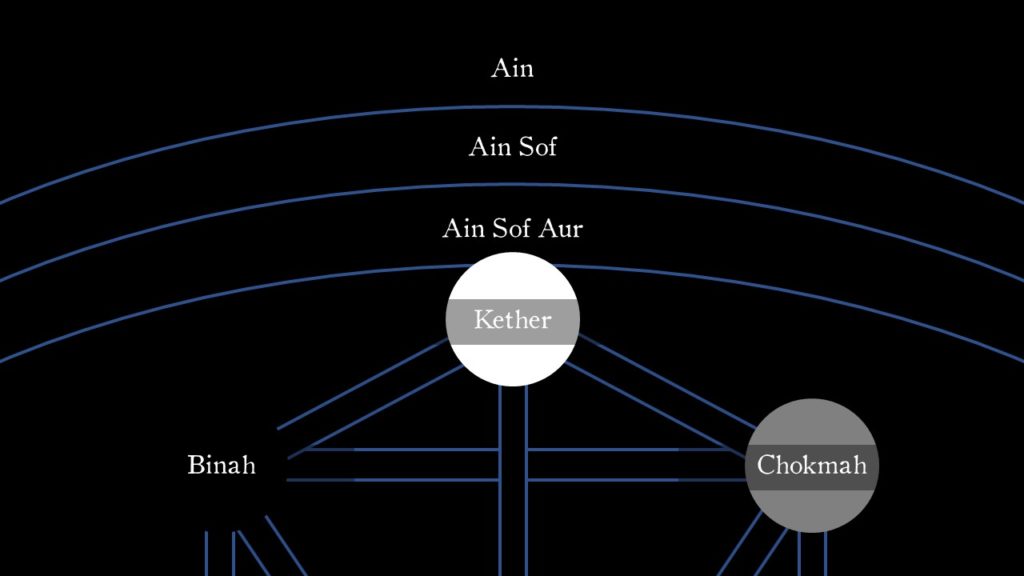
“Beyond” Kether there are the purely transcendent, incomprehensible aspects of divinity, which in Kabbalah are called Ain (Nothingness) and Ain Sof (without limit/infinity). The Hermetic Qabalah of Knorr von Rosenroth and the Golden Dawn includes Ain Sof Aur (limitless light) as a third “negative veil”.
In Kabbalah Ain and Ain Sof (being and nothingness, essentially) are considered to be identical with one another, and Ain Sof is for all intents and purposes identical with Kether.
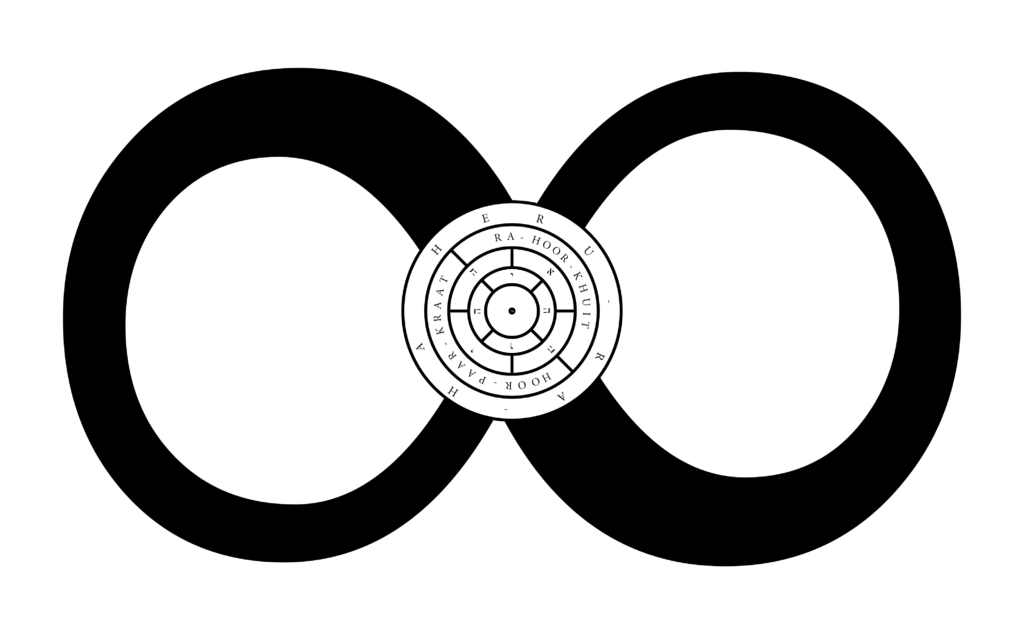
Kether (Heru-Ra-Ha) as the Manifestation of the Interaction between Nuit (infinity) and Hadit (the inverse of infinity) (more…)
Thelema is not traditional Jewish mysticism, although Crowley used the terminology and the framework of Qabalah in order to express his own ideas and intentions.
So you find the same idea of a macrocosm divided up into four worlds, and there are parts of the soul which correspond to or “live” in those four worlds, so that the individual’s life or experience is divided across different realms which are ultimately (mystically) one realm.
In Thelema the macrocosm is composed of the interplay or interaction between two principles, Nuit and Hadit.
Nuit represents the sum total of all possibility. She is infinite space. Hadit represents any particular point of view on those possibilities. He is the infinitely small point.
Nuit is analogous to Ain Sof (infinity) in classical Kabbalah, and Hadit is analogous to Ain (nothingness or the inverse of infinity). Their interaction gives rise to Ra-Hoor-Khuit (sometimes also called Heru-Ra-Ha to include Hoor-paar-kraat), the Crowned and Conquering Child, who is also Ain Sof Aur or Kether.
Since Kether is “pregnant” with Tetragrammaton, you get the familiar breakdown into the remaining nine other sephiroth and the four worlds.

In Thelema the immortal soul of the individual is called the star. This comes from AL I.3 (The Book of the Law, chapter 1, verse 3):
Every man and every woman is a star.
Crowley subdivides the soul or star according to the usual schema of Jechidah, Chiah, Neschamah, Ruach, and Nephesh, but he introduces another subdivision based upon AL I.8-9:
The Khabs is in the Khu, not the Khu in the Khabs. Worship then the Khabs, and behold my light shed over you!
Khabs and Khu are Egyptian terms. In the context of Thelema, Khabs is the “House” of Hadit. Hadit as we saw is the individual point of view on Nuit. Khabs then is the manifestation of that unique interaction. You can think of it almost as the light given off by the energetic interaction between Hadit and Nuit. And in fact in the Golden Dawn—where Crowley would have first encountered this term—Khabs was used as synonymous with light as in the phrase Khabs am Pekht, which means “light in extension” (cf. Ain Sof Aur above).
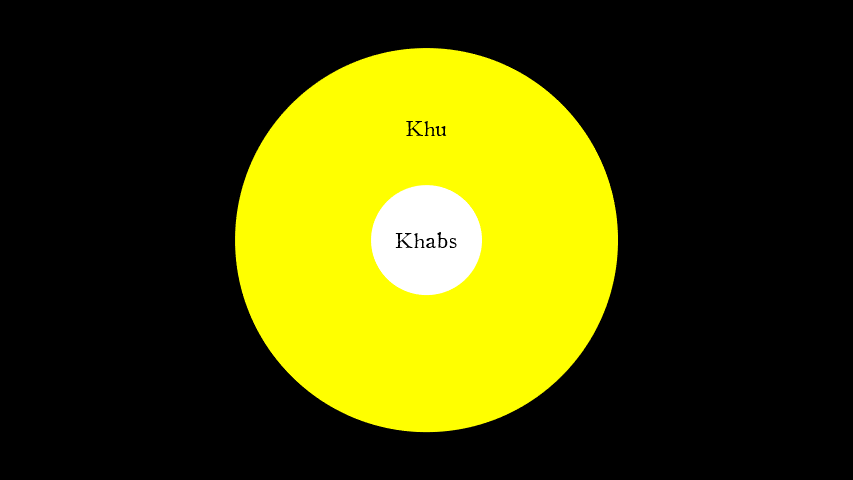
In Thelema the whole of the supernal triad—Kether, Chokmah, and Binah—is considered to be the Khabs. Kether is the essence of the Khabs, taken in and of itself, which is also called Jechidah. Chokmah represents Chiah, the creative impulse or will of the Jechidah. In other words, Chokmah/Chiah represents the mode of going or expression which is characteristic of this particular Khabs or soul. And finally Binah represents the Neschamah of the Khabs. It is the intelligence or intuition of what the Khabs wishes to discover about itself.
It might help to translate these terms into those of ordinary self-conscious.
I have a self which seems stable over time. This is like the Jechidah or Kether. That self or subject is capable of generating thoughts and other mental states. The analog in the supernal triad would be Chiah or Chokmah. Finally, when I hear thoughts in my head, I am able (if I am not insane!) to recognize them as mine. This capacity of self-recognition is analogous to Neschamah or Binah.
Both ordinary self-consciousness and the supernal triad have this triadic or circular structure.
That’s plenty for today. Here are the main takeaways:
Next time we’ll consider the Khu and its relationship to the Khabs and the Tree of Life.

I was recently inspired to create an animated movie based upon my understanding of the Path in Eternity and its relation to certain magical formulae.
The phrase Path in Eternity comes from a passage in Magick Without Tears where Aleister Crowley is describing the initiation rituals of the Man of Earth degree of Ordo Templi Orientis.
Let us begin at the beginning. What is a Dramatic Ritual? It is a celebration of the Adventures of the God whom it is intended to invoke. (The Bacchae of Euripides is a perfect example of this.) Now, in the O.T.O., the object of the ceremonies being the Initiation of the Candidate, it is he whose Path in Eternity is displayed in dramatic form.
Magick Without Tears, Chapter 13, The System of the O.T.O.
He then describes this Path in Eternity in relation to the six sub-degrees of the Man of Earth in the following way:
There are three important conclusions to draw here.
First, as in the mystery schools of the ancient world, the purpose of O.T.O. initiation—in particular, this series of six sub-degrees that comprises the Man of Earth—is to introduce a single individual or candidate to a single god. The main difference between the O.T.O. initiations and those predecessor schools is that in O.T.O., the god the candidate is being introduced to is none other than themselves. In Thelema, the term for this god—the divine part of each individual—is the Secret Self or Hadit.
Second, the purpose of the Man of Earth initiations is to dramatize the “path” taken by this god: a complete cycle in which the soul is drawn into incarnation, dies, and is withdrawn back into nothingness. The initiations are conducted in service to and with reverence toward that way of going which is characteristic of the Hadit which all of us truly is. The Path in Eternity is that toward which the entire series of rituals is oriented. The rituals derive their meanings from that Path.
Third, that path has a characteristic shape. It’s cyclical. It’s a passage from silence to speech and back to silence again. This is the exact same path as that taken by the Holy Guardian Angel which Crowley describes in Liber DCLXXI vel Pyramidos and which I quote at the beginning of the video:
For from the Silence of the Wand
Unto the Speaking of the Sword,
And back again to the Beyond,
This is the toil & the Reward.
This is the Path of HVA—Ho!
This is the Path of IAO.
So one of the first points I’m making in the video is that the Man of Earth series of initiations connects at a deep level with one of the core concepts of Thelema, namely, the idea of the Secret Self aka Hadit aka the Holy Guardian Angel.
The particular way in which it connects with that core concept is to show the characteristic going of that god, and to show how that way of going makes contact with an individual human life. In other words the conditions we find ourselves subject to—birth, aging, and death—are not incidental or exterior to our divinity. In fact they are necessary components of the way our divinity expresses itself.
This helps us begin to make sense of another one of the claims Crowley makes about these rituals:
The main objects of the instruction were two. It was first necessary to explain the universe and the relations of human life therewith. Second, to instruct every man how best to adapt his life to the cosmos and to develop his faculties to the utmost advantage. I accordingly constructed a series of rituals, Minerval, Man, Magician, Master-Magician, Perfect Magician and Perfect Initiate, which should illustrate the course of human life in its largest philosophical aspect. I begin by showing the object of the pure soul, “One, individual and eternal”, in determining to formulate itself consciously, or, as I may say, to understand itself.
Aleister Crowley, Confessions
This larger, universal context in which Crowley wishes to situate or orient the individual human life is the aforementioned Path in Eternity, which in turn is the characteristic way of going of Hadit.